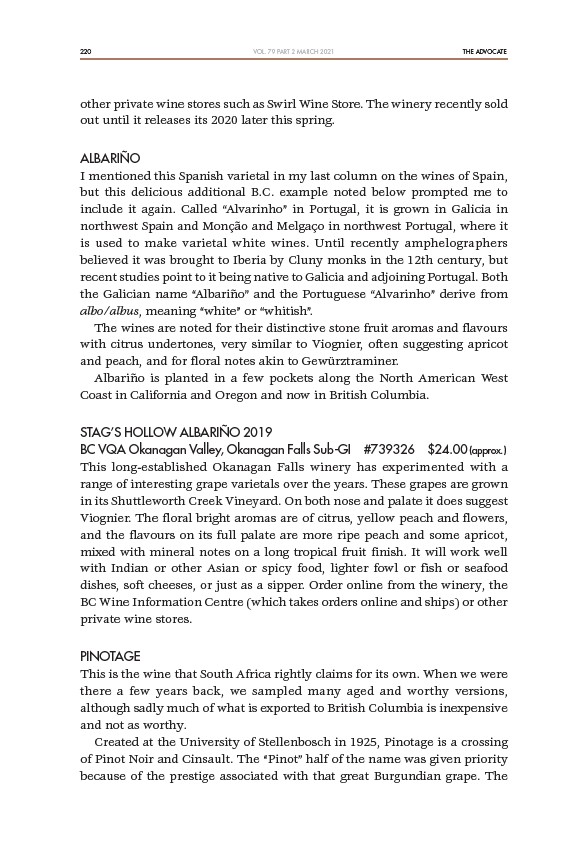
220 THE ADVOCATE
VOL. 79 PART 2 MARCH 2021
other private wine stores such as Swirl Wine Store. The winery recently sold
out until it releases its 2020 later this spring.
ALBARIÑO
I mentioned this Spanish varietal in my last column on the wines of Spain,
but this delicious additional B.C. example noted below prompted me to
include it again. Called “Alvarinho” in Portugal, it is grown in Galicia in
northwest Spain and Monção and Melgaço in northwest Portugal, where it
is used to make varietal white wines. Until recently amphelographers
believed it was brought to Iberia by Cluny monks in the 12th century, but
recent studies point to it being native to Galicia and adjoining Portugal. Both
the Galician name “Albariño” and the Portuguese “Alvarinho” derive from
albo/albus, meaning “white” or “whitish”.
The wines are noted for their distinctive stone fruit aromas and flavours
with citrus undertones, very similar to Viognier, often suggesting apricot
and peach, and for floral notes akin to Gewürztraminer.
Albariño is planted in a few pockets along the North American West
Coast in California and Oregon and now in British Columbia.
STAG’S HOLLOW ALBARIÑO 2019
BC VQA Okanagan Valley, Okanagan Falls Sub-GI #739326 $24.00 (approx.)
This long-established Okanagan Falls winery has experimented with a
range of interesting grape varietals over the years. These grapes are grown
in its Shuttleworth Creek Vineyard. On both nose and palate it does suggest
Viognier. The floral bright aromas are of citrus, yellow peach and flowers,
and the flavours on its full palate are more ripe peach and some apricot,
mixed with mineral notes on a long tropical fruit finish. It will work well
with Indian or other Asian or spicy food, lighter fowl or fish or seafood
dishes, soft cheeses, or just as a sipper. Order online from the winery, the
BC Wine Information Centre (which takes orders online and ships) or other
private wine stores.
PINOTAGE
This is the wine that South Africa rightly claims for its own. When we were
there a few years back, we sampled many aged and worthy versions,
although sadly much of what is exported to British Columbia is inexpensive
and not as worthy.
Created at the University of Stellenbosch in 1925, Pinotage is a crossing
of Pinot Noir and Cinsault. The “Pinot” half of the name was given priority
because of the prestige associated with that great Burgundian grape. The